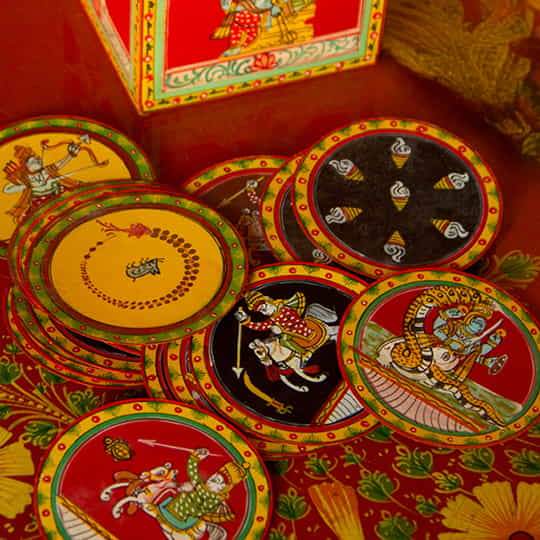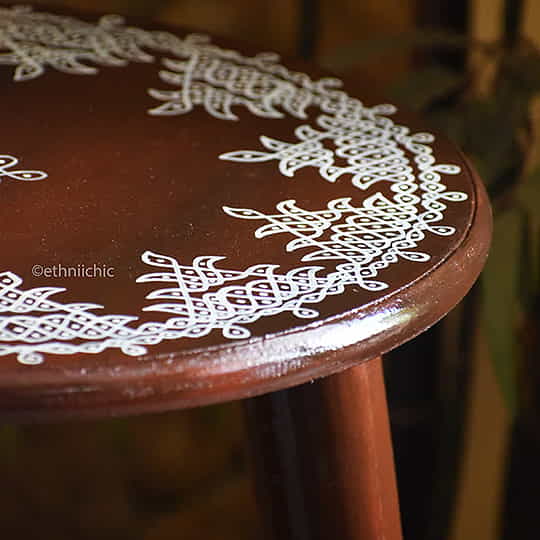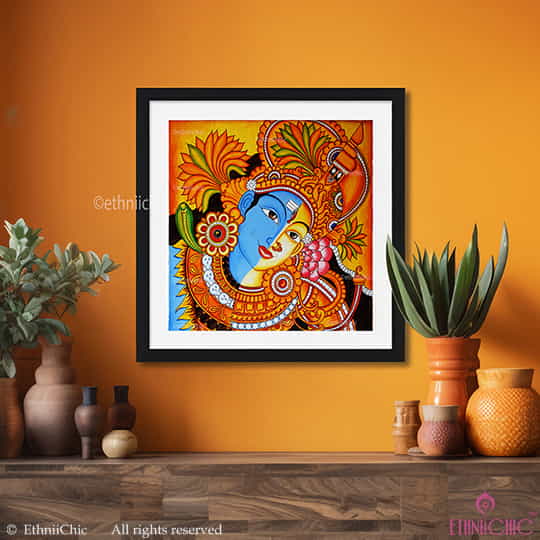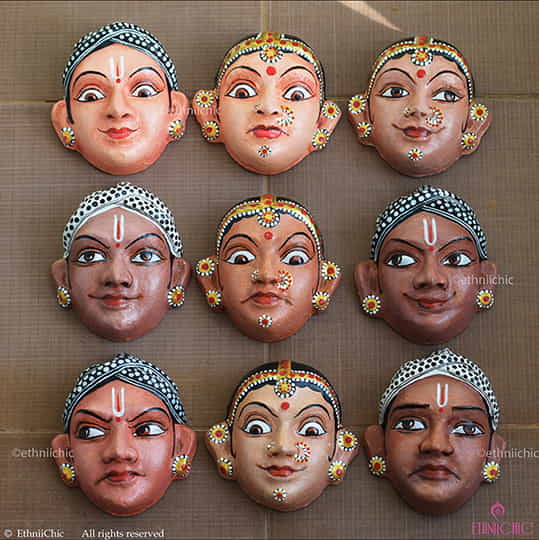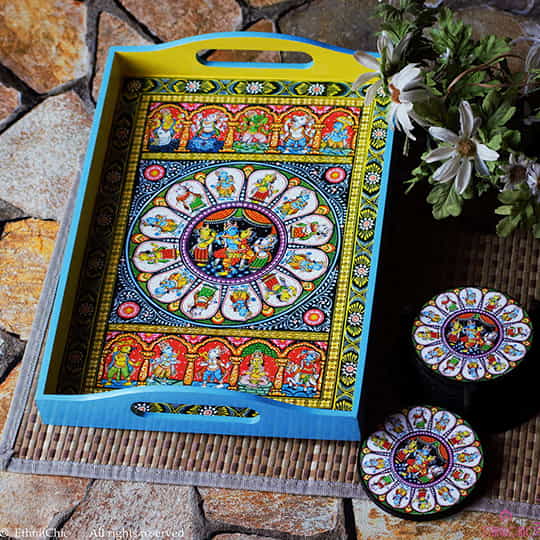The old shop smelled of time itself—a mixture of dust, drying paint, and the soft, lingering scent of age-old stories. Ravi, a young art enthusiast, stepped inside, his fingers tracing the worn wooden frames of paintings stacked one upon another. His eyes flitted from one vibrant piece to another, captivated by the intricate detailing and the bold colors that seemed to bring mythical tales to life.
“Ah, I see you are drawn to these treasures!” an elderly voice interrupted his reverie. Ravi turned to see a bearded man, his hands smudged with dried paint, eyes twinkling with the knowledge of a thousand tales. “I am Govind, the keeper of this collection.”
Ravi smiled. “I’ve always been fascinated by Indian traditional paintings. But today, I’m looking for something specific—Ganjifa and Ganjapa paintings. I know they are both famous, but I can’t quite tell them apart.”
Govind chuckled and gestured to a small corner where two sets of paintings were displayed side by side. “You have an eye for art, young man! Ganjifa and Ganjapa are both deeply rooted in India’s artistic heritage. They share a love for storytelling, mythology, and intricate detailing. But if you look closely, their differences are as striking as their beauty. Let me take you on a journey through time.”
The Shared Heritage: Mythology and Mastery
Govind took a seat and motioned for Ravi to do the same. “Both Ganjifa and Ganjapa paintings celebrate Indian mythology, particularly stories from the Ramayana, Mahabharata, and tales of Lord Vishnu, Krishna, and Jagannath. The artists behind these paintings are deeply connected to their heritage, preserving traditions that have been passed down for centuries.”
Ravi nodded. “That explains why they seem so similar at first glance.”
“Indeed! Both styles use natural pigments, handmade materials, and a devotion to detail. But their history and execution are vastly different. Let’s begin with Ganjifa.”
The History of Ganjifa Paintings
Govind reached for a small round piece of wood, painted in bright hues with delicate patterns encircling a deity at its center. “Ganjifa originated as a card game, introduced to India by the Mughals but later adapted by Indian artisans into something truly unique. The word ‘Ganjifa’ comes from the Persian word ‘Ganjifeh,’ meaning playing cards.”
Ravi leaned in, fascinated. “So it wasn’t just an art form, but a game?”
“Exactly! Ganjifa cards were crafted using layers of cloth, wood, or even ivory, and then painted meticulously. The most famous ones were made in Odisha, Maharashtra, and Mysore. Over time, Hindu rulers embraced Ganjifa, and artists began incorporating mythological themes, replacing Persian motifs with Hindu gods and goddesses.”
He handed Ravi another piece, smaller yet equally intricate. “These cards were used in games played by royalty, much like modern-day playing cards but far more artistic. Over time, the art itself became revered, evolving beyond the game into standalone painted pieces.”
Regional Variations of Ganjifa in India
Govind continued, “As Ganjifa spread across India, different regions developed their own unique styles.”
- Mysore Ganjifa: Known for its exquisite detailing, Mysore Ganjifa features circular cards with themes inspired by the Dashavatara and other Hindu deities. The artists use traditional gold leaf work, making the cards look regal and intricate.
- Karnataka Ganjifa: In Karnataka, Ganjifa cards were traditionally used in temples as a means of storytelling and religious education. The designs here are bold, featuring folk-style illustrations with rich colors.
- Rajasthan Ganjifa: The Rajasthani version often incorporates Rajput miniature painting techniques, featuring courtly and mythological themes with an emphasis on intricate backgrounds and floral motifs.
- Mughal Ganjifa: Under the Mughal influence, the designs included Persian aesthetics, floral patterns, and a mix of Hindu and Islamic motifs. These cards were highly refined and luxurious, often made from ivory and decorated with gold.
- Sawantwadi Ganjifa: Sawantwadi, in Maharashtra, remains one of the last strongholds of Ganjifa card-making. The artisans of Sawantwadi continue to create these hand-painted cards, preserving the legacy of the game and its artistic beauty.
The History of Ganjapa Paintings
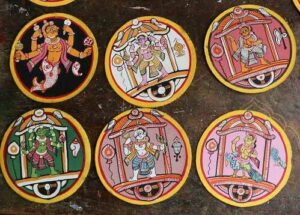
By Vaigupta – Own work, CC BY-SA 4.0, https://commons.wikimedia.org/w/index.php?curid=138182516
Govind then turned Ravi’s attention to another set of round painted pieces. “Now, this is Ganjapa, a traditional form of playing card art from Odisha. While Ganjifa has Persian and Mughal influences, Ganjapa is purely indigenous to India. It evolved in Odisha, particularly in the regions of Puri and Ganjam, where it was closely associated with temple traditions.”
Ravi observed the artwork carefully. “It does look similar to Ganjifa, but there’s something different about it.”
“That’s right,” Govind affirmed. “Ganjapa is deeply linked to Lord Jagannath and local folklore. The paintings on these cards are often inspired by the Dasavatara—the ten incarnations of Lord Vishnu. Unlike Ganjifa, which was played by nobles and kings, Ganjapa was popular among common folk, including fishermen and villagers.”
“So while Ganjifa had a royal audience, Ganjapa was a people’s game?” Ravi asked.
“Exactly!” Govind smiled. “And because of this, Ganjapa cards are often brighter, bolder, and more rustic in execution compared to the refined elegance of Ganjifa.”
How to Recognize the Differences
Govind picked up a Ganjifa card and a Ganjapa card and placed them side by side. “Now, if you ever find yourself in an art market wondering which is which, here’s how you tell them apart.”
1. Origin and Cultural Influence
- Ganjifa: Persian-Mughal influence, adapted by Hindu rulers.
- Ganjapa: Indigenous to Odisha, closely linked to Jagannath culture.
2. Material and Form
- Ganjifa: Painted on small, round, or rectangular pieces of cloth, wood, or ivory. Used as playing cards for royalty.
- Ganjapa: Made from stiffened cloth or palm leaves, primarily circular in shape. Played by common folk.
3. Purpose and Usage
- Ganjifa: Originally a game for nobles, later turned into an art form.
- Ganjapa: A popular village pastime, still played in rural Odisha.
4. Artistic Style and Technique
- Ganjifa: Highly detailed, intricate, and symmetrical with Persian-Mughal aesthetic.
- Ganjapa: Bolder, more vibrant, with folk-style detailing.
5. Color Palette and Themes
- Ganjifa: Rich jewel tones—reds, blues, greens, and gold. Includes Hindu gods, Persian motifs, and royal court scenes.
- Ganjapa: Dominated by bright reds, yellows, and greens. Common themes include Jagannath, Dasavatara, and rural life.
The Art of Preservation
Ravi exhaled, taking in the vast differences between the two art forms. “This is incredible! I never realized how much history is embedded in each brushstroke. But with modern times, are these traditions still alive?”
Govind’s smile faded slightly. “Both forms have suffered with the passage of time. Ganjifa has mostly vanished as a game, surviving only as an artistic tradition. Ganjapa, however, is still played in some villages of Odisha, though it, too, is at risk of being forgotten.”
“Is there a way to support them?” Ravi asked.
“Absolutely! Buying authentic pieces, learning about the art, and spreading awareness help keep these traditions alive. Many artisans also teach workshops, passing down their knowledge to younger generations.”
Ravi picked up a Ganjapa card, tracing the fine lines with admiration. “I think I’d love to start collecting these. Maybe even learn the techniques one day.”
Govind beamed. “Then, my young friend, you are not just a collector—you are a preserver of heritage.”
As Ravi stepped out of the shop, the stories of Ganjifa and Ganjapa paintings stayed with him, woven into the fabric of history like the very brushstrokes that brought them to life.


